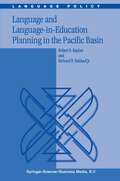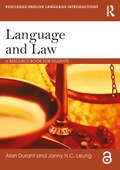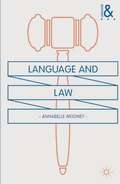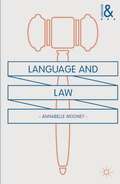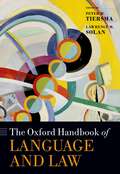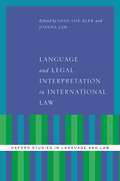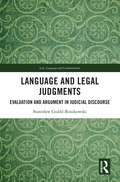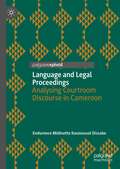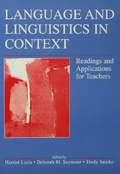- Table View
- List View
Language and Language Acquisition
by F. Lowenthal, F. Vandamme and J. CordierF. LOWENTHAL University of Mons Mons, Belgium In September 1980, researchers from many different countries and working in disciplines as varied as philosophy, psychology, neurology, mathematics, education, linguistics, sociology, and others we forget to mention, again met in Mons to discuss problems concerning Language and Language Acquisition. Conflicting opinions among researchers not only from different disciplines, but also within a same discipline, led to many a lively discussion. This book attempts to recreate the atmosphere of the conference, by reproducing the different papers, some of which were rewritten after the initial presentation and discussion-session, and by giving a summary of each discussion session to enable the reader to understand how each participant reacted. Obviously, we accept full responsibility for these summaries: we hope we have understood correctly what each participant meant. This also holds for the special session devoted to an attempt to define the concept of "language". We suggest that further meetings should study language and context simultaneously, within the framework of a "CONTEXTUAL LINGUISTICS".
Language and Language-in-Education Planning in the Pacific Basin (Language Policy #2)
by R.B. Kaplan Richard B. Baldauf Jr.This work examines and reviews the ecological context of language planning in 14 countries in the Pacific basin: Japan, the two Koreas, Taiwan, the Philippines, Indonesia, Malaysia, Brunei Darussalam, Singapore, Australia, New Zealand, Papua New Guinea, the Solomon Islands and Vanuatu. It provides the only up-to-date overview and review of language policy in the region and challenges those interested in language policy and planning to think about how such goals might be achieved in the context of language ecology.
Language and Law: A resource book for students (Routledge English Language Introductions)
by Alan Durant Janny HC LeungLanguage plays an essential role both in creating law and in governing its implementation. Providing an accessible and comprehensive introduction to this subject, Language and Law: describes the different registers and genres that make up spoken and written legal language and how they develop over time; analyses real-life examples drawn from court cases from different parts of the world, illustrating the varieties of English used in the courtroom by speakers occupying different roles; addresses the challenges presented to our notions of law and regulation by online communication; discusses the complex role of translation in bilingual and multilingual jurisdictions, including Hong Kong and Canada; and provides readings from key scholars in the discipline, including Lawrence Solan, Peter Goodrich, Marianne Constable, David Mellinkoff, and Chris Heffer. With a wide range of activities throughout, this accessible textbook is essential reading for anyone studying language and law or forensic linguistics. Sections A, B, and C of this book are freely available as a downloadable Open Access PDF under a Creative Commons Attribution-Non Commercial-No Derivatives 4.0 license available at http://www.taylorfrancis.com/books/e/9781315436258
Language and Law: A resource book for students (Routledge English Language Introductions)
by Alan Durant Janny HC LeungLanguage plays an essential role both in creating law and in governing its implementation. Providing an accessible and comprehensive introduction to this subject, Language and Law: describes the different registers and genres that make up spoken and written legal language and how they develop over time; analyses real-life examples drawn from court cases from different parts of the world, illustrating the varieties of English used in the courtroom by speakers occupying different roles; addresses the challenges presented to our notions of law and regulation by online communication; discusses the complex role of translation in bilingual and multilingual jurisdictions, including Hong Kong and Canada; and provides readings from key scholars in the discipline, including Lawrence Solan, Peter Goodrich, Marianne Constable, David Mellinkoff, and Chris Heffer. With a wide range of activities throughout, this accessible textbook is essential reading for anyone studying language and law or forensic linguistics. Sections A, B, and C of this book are freely available as a downloadable Open Access PDF under a Creative Commons Attribution-Non Commercial-No Derivatives 4.0 license available at http://www.taylorfrancis.com/books/e/9781315436258
Language and Law: The Role Of Language And Translation In Eu Competition Law
by Silvia Marino Łucja Biel Martina Bajčić Vilelmini SosoniThe book provides an overview of EU competition law with a focus on the main developments in Italy, Spain, Greece, Poland and Croatia and offers an in-depth analysis of the role of language, translation and multilingualism in its implementation and interpretation.The first part of the book focuses on the main developments in EU competition law in action, which includes legislation, case law and praxis. This part can be divided into two subparts: the private enforcement of EU competition law, and the cooperation among enforcers, i.e. the EU Commission, the national competition authorities and the national courts. Language is of paramount importance in the enforcement of EU competition law, and as such, the second part highlights legal linguistic skills, showcasing the advantages and the challenges of multilingualism, especially in the context of the predominant use of English as the EU drafting and vehicular language.The volume brings together contributions prepared and presented as part of the EU-funded research project “Training Action for Legal Practitioners: Linguistic Skills and Translation in EU Competition Law".
Language and Law: Hidden In Plain Sight (Language and...)
by Annabelle MooneyWhat is legal language and where is it found? What does a forensic linguist do? How can linguistic skills help legal professionals?We are constantly surrounded by legal language, but sometimes it is almost impossible to understand. Providing extracts from real-life legal cases, this highly usable and accessible textbook brims with helpful examples and activities that will help you to navigate this area.Language and Law:- Introduces useful linguistic concepts and tools- Outlines the methods linguists employ to analyse legal language and language in legal situations- Includes topics on such as: written legal language; threats, warnings and speech act theory; courtroom interactions and the work linguists do to help solve crimes; physical and 'spoken' signs; and the creativity of legal language
Language and Law: (pdf) (Language and...)
by Annabelle MooneyWhat is legal language and where is it found? What does a forensic linguist do? How can linguistic skills help legal professionals?We are constantly surrounded by legal language, but sometimes it is almost impossible to understand. Providing extracts from real-life legal cases, this highly usable and accessible textbook brims with helpful examples and activities that will help you to navigate this area.Language and Law:- Introduces useful linguistic concepts and tools- Outlines the methods linguists employ to analyse legal language and language in legal situations- Includes topics on such as: written legal language; threats, warnings and speech act theory; courtroom interactions and the work linguists do to help solve crimes; physical and 'spoken' signs; and the creativity of legal language
Language And Law (Oxford Handbooks Ser.)
by Peter M. TiersmaThis book provides a state-of-the-art account of past and current research in the interface between linguistics and law. It outlines the range of legal areas in which linguistics plays an increasing role and describes the tools and approaches used by linguists and lawyers in this vibrant new field. Through a combination of overview chapters, case studies, and theoretical descriptions, the volume addresses areas such as the history and structure of legal language, its meaning and interpretation, multilingualism and language rights, courtroom discourse, forensic identification, intellectual property and linguistics, and legal translation and interpretation. Encyclopaedic in scope, the handbook includes chapters written by experts from every contentint who are familiar with linguistic issues that arise in diverse legal systems, including both civil and common law jurisdictions, mixed systems like that of China, and the emerging law of the European Union.
Language and Learning in a Post-Colonial Context: A Critical Ethnographic Study in Schools in Haiti (Routledge Critical Studies in Multilingualism)
by Marky Jean-PierreThis book explores the social, political, and historical forces that mediate language ideology and practices in post-colonial education and how such ideology and practices influence students’ academic achievement. Jean-Pierre provides empirical evidence that a relationship exists between language practices and school underperformance. He takes Haiti as the focus of study, finding that students and teachers experience difficulty constructing knowledge in a setting in which the language they speak at home (Creole) differs from the language of instruction (French). The research is based on ethnographic data collected in classrooms in both private and public school settings in addition to different sectors of the society (e.g. state and private institutions).
Language and Learning in a Post-Colonial Context: A Critical Ethnographic Study in Schools in Haiti (Routledge Critical Studies in Multilingualism)
by Marky Jean-PierreThis book explores the social, political, and historical forces that mediate language ideology and practices in post-colonial education and how such ideology and practices influence students’ academic achievement. Jean-Pierre provides empirical evidence that a relationship exists between language practices and school underperformance. He takes Haiti as the focus of study, finding that students and teachers experience difficulty constructing knowledge in a setting in which the language they speak at home (Creole) differs from the language of instruction (French). The research is based on ethnographic data collected in classrooms in both private and public school settings in addition to different sectors of the society (e.g. state and private institutions).
Language and Legal Interpretation in International Law (Oxford Studies in Language and Law)
by Anne Lise Kjær and Joanna LamInternational law is usually communicated in more than one language and reflects common norms that lawyers and adjudicators across national legal cultures agree on and develop together. As a result, the negotiation of the wording and meaning of international legislative texts is an integral part of legal interpretation in international law. This book sheds light on that essential interpretation process. Language and Legal Interpretation in International Law treats the subject from the perspective of recent legal and linguistic theories of meaning. Anne Lise Kjær and Joanna Lam bring together internationally renowned experts to provide strong theoretical and practical foundations for the study of legal interpretation in such fields as human rights law, international trade, investment and commercial law, EU law, and international criminal law. The volume explains how the positivist tradition--in which interpretation is understood as an automatic process by which judges simply apply the text of legislative instruments to specific fact situations--cannot be upheld in an era of pragmatic and cognitive meaning theories. Those theories instead focus on the context of interpretation and on the interpreter as a co-producer of meaning. Through a collection of thoroughly researched and timely essays, this book explores the linguistically and culturally diversified world of meaning-making in international law.
Language and Legal Interpretation in International Law (Oxford Studies in Language and Law)
International law is usually communicated in more than one language and reflects common norms that lawyers and adjudicators across national legal cultures agree on and develop together. As a result, the negotiation of the wording and meaning of international legislative texts is an integral part of legal interpretation in international law. This book sheds light on that essential interpretation process. Language and Legal Interpretation in International Law treats the subject from the perspective of recent legal and linguistic theories of meaning. Anne Lise Kjær and Joanna Lam bring together internationally renowned experts to provide strong theoretical and practical foundations for the study of legal interpretation in such fields as human rights law, international trade, investment and commercial law, EU law, and international criminal law. The volume explains how the positivist tradition--in which interpretation is understood as an automatic process by which judges simply apply the text of legislative instruments to specific fact situations--cannot be upheld in an era of pragmatic and cognitive meaning theories. Those theories instead focus on the context of interpretation and on the interpreter as a co-producer of meaning. Through a collection of thoroughly researched and timely essays, this book explores the linguistically and culturally diversified world of meaning-making in international law.
Language and Legal Judgments: Evaluation and Argument in Judicial Discourse (Law, Language and Communication)
by Stanisław Goźdź-RoszkowskiIntegrating research methods from Linguistics with contemporary Legal Argumentation Theory, this book highlights the complexities of legal justification by focusing on the role of value-laden language in argument construction and use. The combination of linguistic analysis and the pragma-dialectic approach to legal argumentation yields a new way of perceiving and understanding the phenomenon of evaluation, one that offers theoretical and practical gains. Analyzing a vast corpus of judicial opinions from the United States Supreme Court and Poland’s Constitutional Court, the book paints a clear picture of complex linguistic choices made by judges to assess and support arguments in the justifications of their decisions. The book will be of interest to scholars in Law, Linguistics and Rhetoric, as well as to judges and practicing lawyers engaged in the art of argumentation.
Language and Legal Judgments: Evaluation and Argument in Judicial Discourse (Law, Language and Communication)
by Stanisław Goźdź-RoszkowskiIntegrating research methods from Linguistics with contemporary Legal Argumentation Theory, this book highlights the complexities of legal justification by focusing on the role of value-laden language in argument construction and use. The combination of linguistic analysis and the pragma-dialectic approach to legal argumentation yields a new way of perceiving and understanding the phenomenon of evaluation, one that offers theoretical and practical gains. Analyzing a vast corpus of judicial opinions from the United States Supreme Court and Poland’s Constitutional Court, the book paints a clear picture of complex linguistic choices made by judges to assess and support arguments in the justifications of their decisions. The book will be of interest to scholars in Law, Linguistics and Rhetoric, as well as to judges and practicing lawyers engaged in the art of argumentation.
Language and Legal Proceedings: Analysing Courtroom Discourse in Cameroon
by Endurence Midinette DissakeThis book investigates language-related problems which arise in courtroom discourse in the Republic of Cameroon, in Central Africa. While Cameroon has over 250 national languages, court cases are conducted in the two official languages: English and French. This is despite the fact that 40% of the adult population is illiterate in these languages, and means that lay litigants often encounter language-related problems during trials. In this study, the author makes use of Speech Act Theory and Interactional Sociolinguistics to analyse the speech acts of both legal professionals and lay litigants as observed in 37 legal cases, demonstrating how the use of exoglossic languages in a highly multilingual nation constitutes a serious issue. The book will be of interest to students and scholars of Forensic Linguistics, Language Policy and Planning, and Discourse Analysis, particularly those with an interest in the African context.
Language and Linguistic Diversity in the US: An Introduction
by Susan Tamasi Lamont AntieauThis highly engaging textbook presents a linguistic view of the history, society, and culture of the United States. It discusses the many languages and forms of language that have been used in the US – including standard and nonstandard forms of English, creoles, Native American languages, and immigrant languages from across the globe – and shows how this distribution and diversity of languages has helped shape and define America as well as an American identity. The volume introduces the basic concepts of sociolinguistics and the politics of language through cohesive, up-to-date and accessible coverage of such key topics as dialectal development and the role of English as the majority language, controversies concerning language use in society, languages other than English used in the US, and the policies that have directly or indirectly influenced language use. These topics are presented in such a way that students can examine the inherent diversity of the communicative systems used in the United States as both a form of cultural enrichment and as the basis for socio-political conflict. The author team outlines the different viewpoints on contemporary issues surrounding language in the US and contextualizes these issues within linguistic facts, to help students think critically and formulate logical discussions. To provide opportunities for further examination and debate, chapters are organized around key misconceptions or questions ("I don't have an accent" or "Immigrants don't want to learn English"), bringing them to the forefront for readers to address directly. Language and Linguistic Diversity in the US is a fresh and unique take on a widely taught topic. It is ideal for students from a variety of disciplines or with no prior knowledge of the field, and a useful text for introductory courses on language in the US, American English, language variation, language ideology, and sociolinguistics.
Language and Linguistic Diversity in the US: An Introduction
by Susan Tamasi Lamont AntieauThis highly engaging textbook presents a linguistic view of the history, society, and culture of the United States. It discusses the many languages and forms of language that have been used in the US – including standard and nonstandard forms of English, creoles, Native American languages, and immigrant languages from across the globe – and shows how this distribution and diversity of languages has helped shape and define America as well as an American identity. The volume introduces the basic concepts of sociolinguistics and the politics of language through cohesive, up-to-date and accessible coverage of such key topics as dialectal development and the role of English as the majority language, controversies concerning language use in society, languages other than English used in the US, and the policies that have directly or indirectly influenced language use. These topics are presented in such a way that students can examine the inherent diversity of the communicative systems used in the United States as both a form of cultural enrichment and as the basis for socio-political conflict. The author team outlines the different viewpoints on contemporary issues surrounding language in the US and contextualizes these issues within linguistic facts, to help students think critically and formulate logical discussions. To provide opportunities for further examination and debate, chapters are organized around key misconceptions or questions ("I don't have an accent" or "Immigrants don't want to learn English"), bringing them to the forefront for readers to address directly. Language and Linguistic Diversity in the US is a fresh and unique take on a widely taught topic. It is ideal for students from a variety of disciplines or with no prior knowledge of the field, and a useful text for introductory courses on language in the US, American English, language variation, language ideology, and sociolinguistics.
Language and Linguistics in Context: Readings and Applications for Teachers
by Harriet Luria Deborah M. Seymour Trudy SmokeTaking a sociocultural and educational approach, Language and Linguistics in Context: Readings and Applications for Teachers:*introduces basic linguistic concepts and current perspectives on language acquisition;*considers the role of linguistic change (especially in English) in the politics of language;*acknowledges the role of linguists in current policies involving language; *offers insights into the relationship between the structure of language systems and first- and second-language acquisition; the study of language across culture, class, race, gender, and ethnicity; and between language study and literacy and education; and*provides readers with a basis for understanding current educational debates about bilingual education, non-standard dialects, English only movements, literacy methodologies, and generally the importance to teaching of the study of language. The text is organized into three thematic units – "What is Language and How is It Acquired?"; "How Does Language Change?"; and "What is Literacy?". To achieve both breadth and depth – that is, to provide a “big picture” view of basic linguistics and at the same time make it specific enough for the beginner – a selection of readings, including personal language narratives, is provided to both introduce and clarify linguistic concepts. The readings, by well-known theoretical and applied linguists and researchers from various disciplines, are diverse in level and range of topics and vary in level of linguistic formalism. Pedagogical features: This text is designed for a range of courses in English and language arts, bilingualism, applied linguistics, and ESL courses in teacher education programs. Each unit contains a substantive introduction to the topic, followed by the readings. Each reading concludes with Questions to Think About including one Extending Your Understanding question, and a short list of Terms to Define. Each unit ends with additional Extending Your Understanding and Making Connections activities that engage readers in applying what they have read to teaching and suggested projects and a bibliography of Print and Web Resources. The readings and apparatus are arranged so that the material can be modified to fit many course plans and schemes of presentation. To help individual instructors make the most effective use of the text in specific classes, a set of matrixes is provided suggesting configurations of readings for different types of linguistics and education classes.
Language and Linguistics in Context: Readings and Applications for Teachers
by Harriet Luria Deborah M. Seymour Trudy SmokeTaking a sociocultural and educational approach, Language and Linguistics in Context: Readings and Applications for Teachers:*introduces basic linguistic concepts and current perspectives on language acquisition;*considers the role of linguistic change (especially in English) in the politics of language;*acknowledges the role of linguists in current policies involving language; *offers insights into the relationship between the structure of language systems and first- and second-language acquisition; the study of language across culture, class, race, gender, and ethnicity; and between language study and literacy and education; and*provides readers with a basis for understanding current educational debates about bilingual education, non-standard dialects, English only movements, literacy methodologies, and generally the importance to teaching of the study of language. The text is organized into three thematic units – "What is Language and How is It Acquired?"; "How Does Language Change?"; and "What is Literacy?". To achieve both breadth and depth – that is, to provide a “big picture” view of basic linguistics and at the same time make it specific enough for the beginner – a selection of readings, including personal language narratives, is provided to both introduce and clarify linguistic concepts. The readings, by well-known theoretical and applied linguists and researchers from various disciplines, are diverse in level and range of topics and vary in level of linguistic formalism. Pedagogical features: This text is designed for a range of courses in English and language arts, bilingualism, applied linguistics, and ESL courses in teacher education programs. Each unit contains a substantive introduction to the topic, followed by the readings. Each reading concludes with Questions to Think About including one Extending Your Understanding question, and a short list of Terms to Define. Each unit ends with additional Extending Your Understanding and Making Connections activities that engage readers in applying what they have read to teaching and suggested projects and a bibliography of Print and Web Resources. The readings and apparatus are arranged so that the material can be modified to fit many course plans and schemes of presentation. To help individual instructors make the most effective use of the text in specific classes, a set of matrixes is provided suggesting configurations of readings for different types of linguistics and education classes.
Language and Literacy
by Sally Neaumhttp://www. uk. sagepub. com/repository/binaries/img/common/nurseryworld13. gif" width="175" height="152" border="0" align="right" /> Shortlisted for the 2013 Nursery World Awards! This is a focused text on early years' language and literacy for all students studying for degrees and foundation degrees in early childhood, early years and related disciplines and for candidates on EYPS pathways. It discusses language acquisition and development and covers development theory, talking with babies and the factors that affect development. Practical guidance on how to support children's language acquisition through rhymes, songs, story books and storytelling helps students see how theory links to practice. The text also examines the question 'what comes before phonics?' and includes interactive activities and theory focus features. About the Early Childhood Studies Series This series has been designed to support students of Early Years, Early Childhood Studies and related disciplines in popular modules of their course. Each text takes a focused look at a specific topic and approaches it in an accessible and user-friendly way. Features have been developed to help readers engage with the text and understand the subject from a number of different viewpoints. Activities pose questions to prompt thought and discussion and 'Theory Focus' boxes examine essential theory close-up for better understanding. This series is also applicable to EYPS candidates on all pathways. Other titles in the series include Early Childhood Studies, Childhood in Society for Early Childhood Studies, Child Development for Early Childhood Studies and Exploring Play for Early Childhood Studies.
Language and Literacy: The Sociolinguistics of Reading and Writing (Routledge Library Editions: Linguistics)
by Michael StubbsDespite a vast amount of study, literacy is still a very confused topic, which requires the integration of findings from different areas. Reading and writing are psychological skills, but they are also linguistic skills (since people read and write meaningful language) and social skills (since written language serves particular functions in different societies). In this book Michael Stubbs provides a basis for a sociolinguistic theory of literacy. He believes that a systematic theory of literacy must be based on an understanding of a number of factors, such as the relationship between written and spoken language, including how English spelling works and how it is related to spoken English. Also of paramount importance are the social, educational and technological pressures on written language, which are particularly powerful in the case of an international language like English; the social and communicative functions which written language serves – largely administrative and intellectual functions; and the variability of spoken language and the relative uniformity of written language. The book also discusses the arguments behind deprivation theory as an explanation of educational failure. Reading failure is not well understood, but the author stresses that a vital element is the attitude of teachers towards the child’s language. He emphasizes that it is important that teachers should understand as much as possible about the relationship between written language and the child’s spoken language. Such understanding, he argues, can only increase tolerance of regional, social and ethnic diversity in language.
Language and Literacy: The Sociolinguistics of Reading and Writing (Routledge Library Editions: Linguistics)
by Michael StubbsDespite a vast amount of study, literacy is still a very confused topic, which requires the integration of findings from different areas. Reading and writing are psychological skills, but they are also linguistic skills (since people read and write meaningful language) and social skills (since written language serves particular functions in different societies). In this book Michael Stubbs provides a basis for a sociolinguistic theory of literacy. He believes that a systematic theory of literacy must be based on an understanding of a number of factors, such as the relationship between written and spoken language, including how English spelling works and how it is related to spoken English. Also of paramount importance are the social, educational and technological pressures on written language, which are particularly powerful in the case of an international language like English; the social and communicative functions which written language serves – largely administrative and intellectual functions; and the variability of spoken language and the relative uniformity of written language. The book also discusses the arguments behind deprivation theory as an explanation of educational failure. Reading failure is not well understood, but the author stresses that a vital element is the attitude of teachers towards the child’s language. He emphasizes that it is important that teachers should understand as much as possible about the relationship between written language and the child’s spoken language. Such understanding, he argues, can only increase tolerance of regional, social and ethnic diversity in language.
Language and Literacy: Functional Approaches
by Rachel Whittaker Anne McCabe Mick O'DonnellThis volume examines the relationship between language and literacy from a systemic functional perspective. The book starts with a retrospective view on the development of language education practices, written by eminent linguistics Michael Halliday and Ruqaiya Hasan, and then shows how this approach is implemented today. The second section presents a detailed analysis of how considerations of literacy education are approached in educational systems around the world. The contributors examine issues such as metadiscourse, genre, cultural politics, and how systemic functional grammar can help to raise literacy standards. The final section looks at literacy in more specific disciplines, including history, literature, science and student writing. The essays collected here present a comprehensive analysis of language and literacy from a systemic functional perspective, written by academics at the forefront of the field. It will be of interest to researchers in systemic functional linguistics, or language and education.
Language and Literacy 3-7: Creative Approaches to Teaching
by Dr Jeni RileyThis practical guide considers the research evidence that is needed to inform enlightened practice, and offers concrete suggestions and teaching approaches for early years settings and classrooms. This comprehensive book shows the 'what' the 'how' and the 'why' of innovative, creative practice for teaching language and literacy. The author clearly examines how young children learn to use both spoken and written language, and shows how to assess, plan and teach for the effective learning of speaking, listening, reading and writing. Each chapter includes case studies, learning and teaching suggestions and further reading, and topics covered include: o Learning to communicate o Developing spoken language in early years settings and classrooms o The links between oracy and literacy o The inter-relatedness of the literacy process o Teaching literacy holistically o The assessment of language and literacy o Supporting literacy in Keystage 1, teaching reading and teaching writing for different purposes o Children and books o Teaching children for whom English is an additional language o Language, literacy, learning and ICT.
Language and Literacy 3-7: Creative Approaches To Teaching (PDF)
by Jeni RileyThis practical guide considers the research evidence that is needed to inform enlightened practice, and offers concrete suggestions and teaching approaches for early years settings and classrooms. This comprehensive book shows the 'what' the 'how' and the 'why' of innovative, creative practice for teaching language and literacy. The author clearly examines how young children learn to use both spoken and written language, and shows how to assess, plan and teach for the effective learning of speaking, listening, reading and writing. Each chapter includes case studies, learning and teaching suggestions and further reading, and topics covered include: o Learning to communicate o Developing spoken language in early years settings and classrooms o The links between oracy and literacy o The inter-relatedness of the literacy process o Teaching literacy holistically o The assessment of language and literacy o Supporting literacy in Keystage 1, teaching reading and teaching writing for different purposes o Children and books o Teaching children for whom English is an additional language o Language, literacy, learning and ICT.

